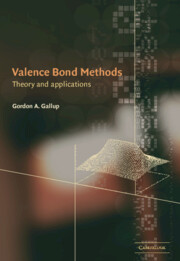Book contents
- Frontmatter
- Contents
- Preface
- List of abbreviations
- I Theory and two-electron systems
- 1 Introduction
- 2 H2 and localized orbitals
- 3 H2 and delocalized orbitals
- 4 Three electrons in doublet states
- 5 Advanced methods for larger molecules
- 6 Spatial symmetry
- 7 Varieties of VB treatments
- 8 The physics of ionic structures
- II Examples and interpretations
- References
- Index
5 - Advanced methods for larger molecules
Published online by Cambridge University Press: 13 August 2009
- Frontmatter
- Contents
- Preface
- List of abbreviations
- I Theory and two-electron systems
- 1 Introduction
- 2 H2 and localized orbitals
- 3 H2 and delocalized orbitals
- 4 Three electrons in doublet states
- 5 Advanced methods for larger molecules
- 6 Spatial symmetry
- 7 Varieties of VB treatments
- 8 The physics of ionic structures
- II Examples and interpretations
- References
- Index
Summary
As was seen in the last chapter, the effect of permutations on portions of the wave function is important in enforcing their correct character. The permutations of n entities form a group in the mathematical sense that is said to be one of the symmetric groups. In particular, when we have all of the permutations of n entities the group is symbolized Sn. In this chapter we give, using the theory of the symmetric groups, a generalization of the special treatment of three electrons discussed above.
There are several more or less equivalent methods for dealing with the twin problems of constructing antisymmetric functions that are also eigenfunctions of the spin. Where orbitals are orthogonal the graphical unitary group approach (GUGA), based upon the symmetric group and unitary group representations, is popular today. With VB functions, which perforce have nonorthogonal orbitals, a significant problem centers around devising algorithms for calculating matrix elements of the Hamiltonian that are efficient enough to be useful. In the past symmetric group methods have been criticized as being overcomplicated. Nevertheless, the present author knows of no other techniques for obtaining what appears to be the optimal algorithm for these calculations.
This chapter is the most complicated and formal in the book. Looking back to Chapter 4 we can obtain an idea of what is needed in general.
- Type
- Chapter
- Information
- Valence Bond MethodsTheory and Applications, pp. 63 - 96Publisher: Cambridge University PressPrint publication year: 2002

